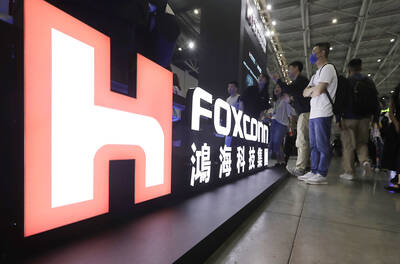India is still adding a staggering 15 million new mobile phone connections a month, but the world’s fastest-growing cellular market has hit rough waters.
A cut-throat price war is hammering down call charges, putting pressure on telecom companies’ earnings and share prices, and threatening a bruising shakeout in a sector that has become crowded with new players.
“The tariff reductions are hitting revenue growth and with new entrants, there’s less to go round for everyone,” Religare Securities analyst Himanshu Shah said.

PHOTO: AFP
Top Indian mobile phone firm Bharti this month announced a lower-than-expected 13 percent rise in quarterly net profit from a year earlier, while profits halved at No. 2 operator Reliance Communications.
EVEN MORE AGGRESSIVE
Competition was already fierce but has become even more aggressive as new players unleash deeper price cuts with innovative per-second billing plans that have pushed call costs down to less than US$0.01 a minute. Some operators are offering rates as low as 0.01 rupees a second, or a fraction of a US cent.
The per-second billing was launched in June by the entry of Tata DoCoMo, a joint venture between India’s Tata Teleservices and Japan’s NTT DoCoMo.
“We’ve seen a wave of price cuts,” said Shubham Majumder of Macquarie Research. “Definitely there’s downside pressure.”
Signs of the trend can be seen in the fall in average revenue per usage (ARPU) — an industry profitability measure — which shows the amount companies make for every minute a client talks.
The ARPU for Reliance Communications for the second quarter ending September slid 23 percent from the preceding quarter, while Bharti’s ARPU fell 9.4 percent.
Akhil Gupta, deputy chief executive of Bharti Airtel’s parent, Bharti Enterprises, said the sector had been afflicted by “irrational pricing.”
The ARPU drop reflected the rock-bottom tariffs as well as growing company reliance on lower-spending rural customers as they push deeper into India’s hinterland to expand revenues.
Total telephone penetration, including landline and mobile phones, in the country of nearly 1.2 billion stands at 43 percent — up from 2.8 percent in 2000 and testimony to the telecom sector’s blistering growth.
India added 14.98 million new phone customers in September, pushing the number of users to more than 500 million — 15 months ahead of a government target for reaching the milestone.
The boom in phone connections has been overwhelmingly driven by cellular services, with mobile customers comprising 40.31 percent of the 500 million telephone users.
India is the world’s second biggest cellular market, lagging behind only China, which has more than 600 million users.
SATURATED
Urban mobile markets are already saturated but there are still hundreds of millions of customers to be signed up in rural areas — a tantalizing prospect for new entrants that see India as one of the few global growth areas.
Another four players, including Norway’s Telenor and United Arab Emirates’ Etisalat, are set to roll out services in the next few months, joining the 11 companies already pitching for customers.
As competition has mounted, the companies’ share prices have taken a hit, with market leaders Bharti sliding 30 percent in a month and Reliance Communications tumbling 45 percent.
Investment house MacQuarie recently downgraded the sector to “under-perform.”
India plans to hold an auction in January for third-generation spectrum, which will allow high-speed Internet and video downloads on mobile phones.
But analysts say it will take time for companies to earn back the money spent on the licenses and that the auction will add to their balance-sheet burdens.
Experts say the sector can only reasonably support four to five players and that consolidation looms.
“These developments will accelerate industry consolidation over the next 18 to 24 months,” said Satish Seth, group managing director of Reliance Communications, adding that Reliance would be a survivor.
A shakeout will ultimately be beneficial for the industry as it would allow those who emerge on top to restore pricing, analysts say.

A proposed 100 percent tariff on chip imports announced by US President Donald Trump could shift more of Taiwan’s semiconductor production overseas, a Taiwan Institute of Economic Research (TIER) researcher said yesterday. Trump’s tariff policy will accelerate the global semiconductor industry’s pace to establish roots in the US, leading to higher supply chain costs and ultimately raising prices of consumer electronics and creating uncertainty for future market demand, Arisa Liu (劉佩真) at the institute’s Taiwan Industry Economics Database said in a telephone interview. Trump’s move signals his intention to "restore the glory of the US semiconductor industry," Liu noted, saying that

On Ireland’s blustery western seaboard, researchers are gleefully flying giant kites — not for fun, but in the hope of generating renewable electricity and sparking a “revolution” in wind energy. “We use a kite to capture the wind and a generator at the bottom of it that captures the power,” said Padraic Doherty of Kitepower, the Dutch firm behind the venture. At its test site in operation since September 2023 near the small town of Bangor Erris, the team transports the vast 60-square-meter kite from a hangar across the lunar-like bogland to a generator. The kite is then attached by a

Foxconn Technology Co (鴻準精密), a metal casing supplier owned by Hon Hai Precision Industry Co (鴻海精密), yesterday announced plans to invest US$1 billion in the US over the next decade as part of its business transformation strategy. The Apple Inc supplier said in a statement that its board approved the investment on Thursday, as part of a transformation strategy focused on precision mold development, smart manufacturing, robotics and advanced automation. The strategy would have a strong emphasis on artificial intelligence (AI), the company added. The company said it aims to build a flexible, intelligent production ecosystem to boost competitiveness and sustainability. Foxconn

STILL UNCLEAR: Several aspects of the policy still need to be clarified, such as whether the exemptions would expand to related products, PwC Taiwan warned The TAIEX surged yesterday, led by gains in Taiwan Semiconductor Manufacturing Co (TSMC, 台積電), after US President Donald Trump announced a sweeping 100 percent tariff on imported semiconductors — while exempting companies operating or building plants in the US, which includes TSMC. The benchmark index jumped 556.41 points, or 2.37 percent, to close at 24,003.77, breaching the 24,000-point level and hitting its highest close this year, Taiwan Stock Exchange (TWSE) data showed. TSMC rose NT$55, or 4.89 percent, to close at a record NT$1,180, as the company is already investing heavily in a multibillion-dollar plant in Arizona that led investors to assume